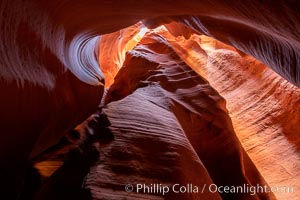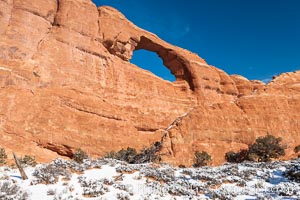
Owl Canyon, a beautiful slot canyon that is part of the larger Antelope Canyon system. Page, Arizona.
Location: Navajo Tribal Lands, Page, Arizona
Image ID: 36028
Location: Navajo Tribal Lands, Page, Arizona
Image ID: 36028

Rattlesnake Canyon, a beautiful slot canyon that is part of the larger Antelope Canyon system. Page, Arizona.
Location: Navajo Tribal Lands, Page, Arizona
Image ID: 36034
Location: Navajo Tribal Lands, Page, Arizona
Image ID: 36034

Rattlesnake Canyon, a beautiful slot canyon that is part of the larger Antelope Canyon system. Page, Arizona.
Location: Navajo Tribal Lands, Page, Arizona
Image ID: 36038
Location: Navajo Tribal Lands, Page, Arizona
Image ID: 36038

Lower Antelope Canyon, a deep, narrow and spectacular slot canyon lying on Navajo Tribal lands near Page, Arizona.
Location: Navajo Tribal Lands, Page, Arizona
Image ID: 37767
Location: Navajo Tribal Lands, Page, Arizona
Image ID: 37767

Lower Antelope Canyon, a deep, narrow and spectacular slot canyon lying on Navajo Tribal lands near Page, Arizona.
Location: Navajo Tribal Lands, Page, Arizona
Image ID: 37768
Location: Navajo Tribal Lands, Page, Arizona
Image ID: 37768

Lower Antelope Canyon, a deep, narrow and spectacular slot canyon lying on Navajo Tribal lands near Page, Arizona.
Location: Navajo Tribal Lands, Page, Arizona
Image ID: 37773
Location: Navajo Tribal Lands, Page, Arizona
Image ID: 37773
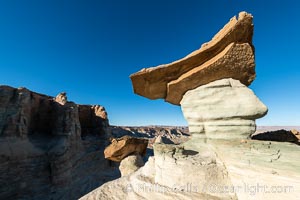
Pedestal rock, or hoodoo, at Stud Horse Point. These hoodoos form when erosion occurs around but not underneath a more resistant caprock that sits atop of the hoodoo spire. Stud Horse Point is a spectacular viewpoint on a mesa overlooking the Arizona / Utah border.
Location: Page, Arizona
Image ID: 37778
Location: Page, Arizona
Image ID: 37778

Pedestal rock, or hoodoo, at Stud Horse Point. These hoodoos form when erosion occurs around but not underneath a more resistant caprock that sits atop of the hoodoo spire. Stud Horse Point is a spectacular viewpoint on a mesa overlooking the Arizona / Utah border.
Location: Page, Arizona
Image ID: 37780
Location: Page, Arizona
Image ID: 37780

Turret Arch viewed through North Window at Sunrise.
Location: North Window, Arches National Park, Utah
Image ID: 37863
Location: North Window, Arches National Park, Utah
Image ID: 37863
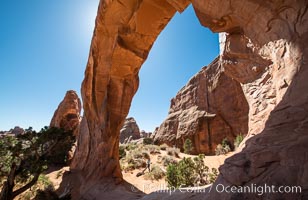
Pine Tree Arch, Arches National Park.
Location: Pine Tree Arch, Arches National Park, Utah
Image ID: 37865
Location: Pine Tree Arch, Arches National Park, Utah
Image ID: 37865
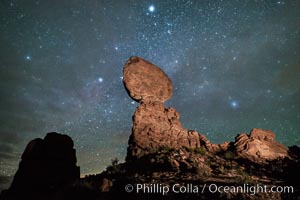
Moon and Stars over Balanced Rock, Arches National Park.
Location: Balanced Rock, Arches National Park, Utah
Image ID: 29236
Location: Balanced Rock, Arches National Park, Utah
Image ID: 29236

Stars over the Organ, Courthouse Towers, Arches National Park.
Location: Courthouse Towers, Arches National Park, Utah
Image ID: 29272
Location: Courthouse Towers, Arches National Park, Utah
Image ID: 29272
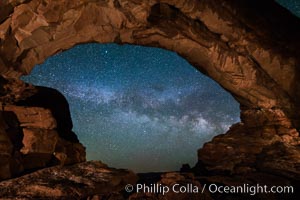
Milky Way through North Window, Arches National Park.
Location: North Window, Arches National Park, Utah
Image ID: 29277
Location: North Window, Arches National Park, Utah
Image ID: 29277

Delicate Arch with Stars and Moon, at night, Arches National Park.
Location: Delicate Arch, Arches National Park, Utah
Image ID: 29287
Location: Delicate Arch, Arches National Park, Utah
Image ID: 29287

Milky Way and Stars over Delicate Arch, at night, Arches National Park, Utah.
Location: Delicate Arch, Arches National Park, Utah
Image ID: 29299
Location: Delicate Arch, Arches National Park, Utah
Image ID: 29299
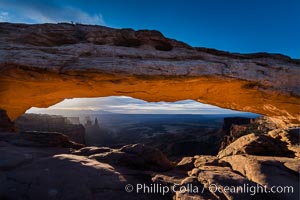
Mesa Arch Sunrise, Canyonlands National Park, Utah.
Location: Mesa Arch, Canyonlands National Park, Utah
Image ID: 29301
Location: Mesa Arch, Canyonlands National Park, Utah
Image ID: 29301
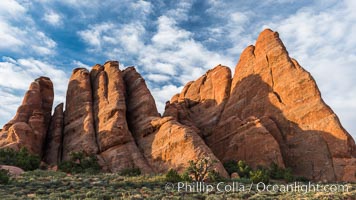
Sunrise light touches the Fins. Sandstone fins stand on edge. Vertical fractures separate standing plates of sandstone that are eroded into freestanding fins, that may one day further erode into arches.
Location: Arches National Park, Utah
Image ID: 29255
Location: Arches National Park, Utah
Image ID: 29255
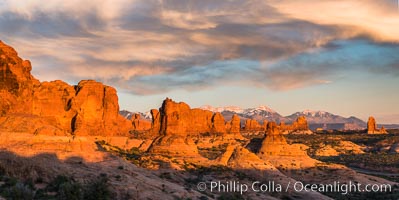
Sunset over Garden of the Gods, Arches National Park.
Location: Garden of the Gods, Arches National Park, Utah
Image ID: 29261
Panorama dimensions: 4108 x 8190
Location: Garden of the Gods, Arches National Park, Utah
Image ID: 29261
Panorama dimensions: 4108 x 8190

Mesa Arch spans 90 feet and stands at the edge of a mesa precipice thousands of feet above the Colorado River gorge. For a few moments at sunrise the underside of the arch glows dramatically red and orange.
Location: Island in the Sky, Canyonlands National Park, Utah
Image ID: 18085
Location: Island in the Sky, Canyonlands National Park, Utah
Image ID: 18085

Landscape Arch in winter. Landscape Arch has an amazing 306-foot span.
Location: Landscape Arch, Arches National Park, Utah
Image ID: 18115
Location: Landscape Arch, Arches National Park, Utah
Image ID: 18115
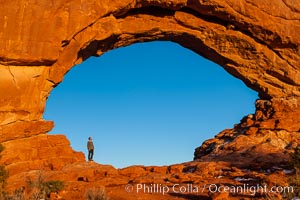
Hiker in North Window, sunset, western face. North Window is a natural sandstone arch 90 feet wide and 48 feet high.
Location: North Window, Arches National Park, Utah
Image ID: 18160
Location: North Window, Arches National Park, Utah
Image ID: 18160

Pine Tree Arch on the Devil's Garden Trail in Arches National Park.
Location: Pine Tree Arch, Arches National Park, Utah
Image ID: 18186
Location: Pine Tree Arch, Arches National Park, Utah
Image ID: 18186

Fins. The vertical slabs of Entrada sandstone may become natural sandstone arches.
Location: Arches National Park, Utah
Image ID: 18187
Location: Arches National Park, Utah
Image ID: 18187

The Organ at Courthouse Towers, narrow sandstone fins towering above the surrounding flatlands.
Location: Courthouse Towers, Arches National Park, Utah
Image ID: 18195
Location: Courthouse Towers, Arches National Park, Utah
Image ID: 18195

Mobius Arch in golden early morning light. The natural stone arch is found in the scenic Alabama Hlls near Lone Pine, California.
Location: Alabama Hills Recreational Area, California
Image ID: 21731
Location: Alabama Hills Recreational Area, California
Image ID: 21731

The long shadow of a hiker lies on Mobius Arch, a natural stone arch in the Alabama Hills.
Location: Alabama Hills Recreational Area, California
Image ID: 21733
Location: Alabama Hills Recreational Area, California
Image ID: 21733
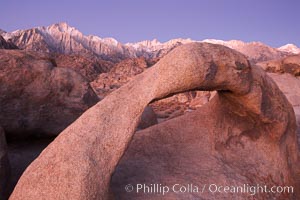
Mobius Arch, the Alabama Hills and the Sierra Nevada Range at sunrise, pink early morning light.
Location: Alabama Hills Recreational Area, California
Image ID: 21734
Location: Alabama Hills Recreational Area, California
Image ID: 21734

Aerial View of the San Rafael Reef, Utah. This is a canyon-like section of the San Rafael Reef, photographed at sunrise. The "reef proper" is on the right, with its characteristic triangular flatiron erosion. The canyon in the center is a fold in the Earth's crust affiliated with the boundary of the San Rafael Swell. The colors seen here arise primarily from Navajo and Wingate sandstone.
Location: Utah
Image ID: 39496
Location: Utah
Image ID: 39496
